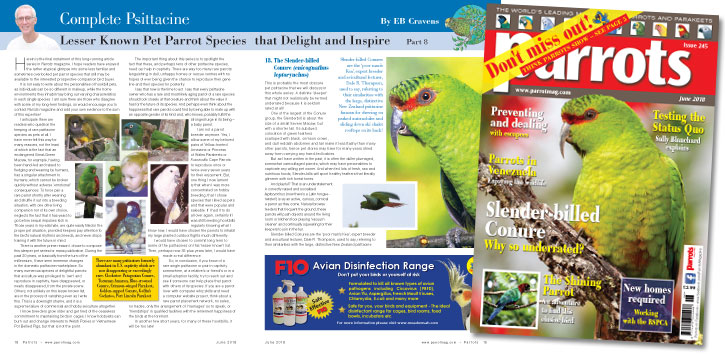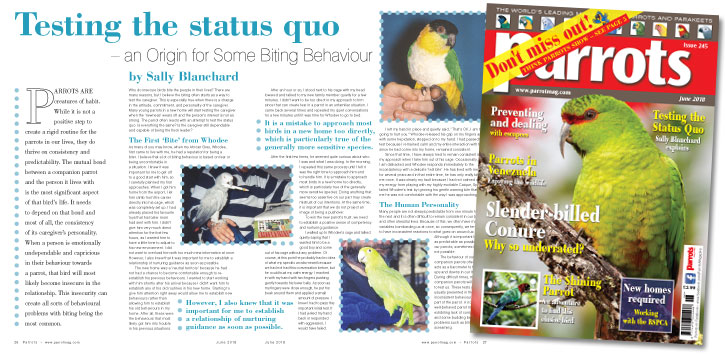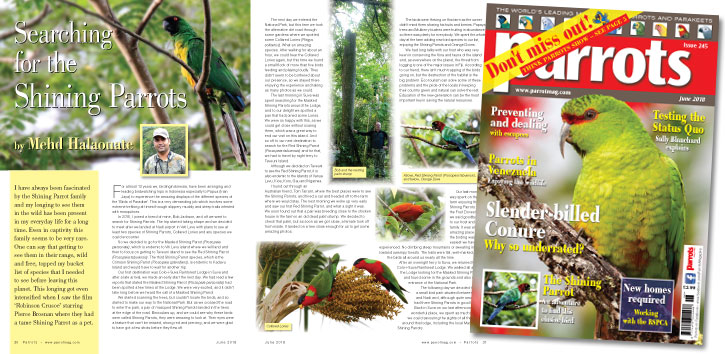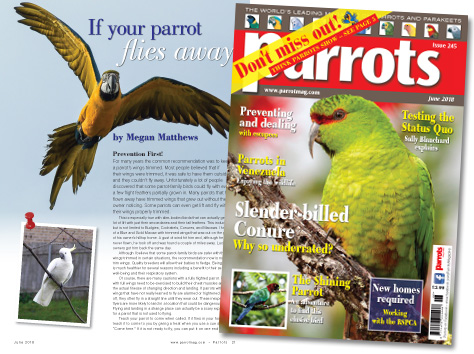
Complete Psittacine by EB Cravens
Herein is the final instalment of this long-running article series in Parrots magazine. I hope readers have enjoyed the rather atypical glimpse into some less familiar and sometimes overlooked pet parrot species that still may be available to the interested prospective companion bird buyer.
It is not easy to write about the personalities of hookbill pets, as individuals can be so different in makeup, while the home environments they inhabit may bring out varying characteristics in each single species. I am sure there are those who disagree with some of my long-term findings, so would encourage you to contact Parrots magazine and add your own evidence to the sum of this expertise!
I anticipate there are readers who question the keeping of rare psittacine species as pets at all. I have never felt this way for many reasons, not the least of which is the fact that an endangered Great-Green Macaw, for example, having been hand-fed and raised to fledging and weaning by humans, has a singular attachment to humans, which cannot be broken quickly without adverse ‘emotional’ consequences. To force pair a rare parrot shortly after weaning and shuffle it out into a breeding situation, with one other living companion not of its own choice, neglects the fact that it has years to go before sexual impulses kick in. Those years in my estimate, are quite easily filled in the proper pet situation, provided keepers pay attention to the bird’s natural rhythms and needs, and never stops training it with the future in mind.
There is another prime reason I chose to compose this sleeper pet series for mass publication. During the past 20 years, or basically from the turn of the millennium, I have seen immense changes in the domestic psittacine marketplace. So many numerous species of delightful parrots that aviculture was privileged to ‘own’ and reproduce in captivity, have disappeared, or nearly disappeared, from the private scene. Others, not unlikely on this lesser known list, are in the process of vanishing even as I write this. This is a downright shame, and it is a supreme failure of commercial and hobby aviculture altogether.
Buy Now!

By Sally Blanchard
Parrots are creatures of habit. While it is not a positive step to create a rigid routine for the parrots in our lives, they do thrive on consistency and predictability. The mutual bond between a companion parrot and the person it lives with is the most significant aspect of that bird’s life. It needs to depend on that bond and most of all, the consistency of its caregiver’s personality. When a person is emotionally undependable and capricious in their behaviour towards a parrot, that bird will most likely become insecure in the relationship. This insecurity can create all sorts of behavioural problems with biting being the most common.
Why do insecure birds bite the people in their lives? There are many reasons, but I believe the biting often starts as a way to test the caregiver. This is especially true when there is a change in the attitude, commitment, and personality of the caregiver. Many young parrots in a new home will start testing the caregiver when the ‘newness’ wears off and the person’s interest is not as strong. The parrot often reacts with an attempt to test the status quo. Is everything the same? Is the caregiver still dependable and capable of being the flock leader?
Buy Now!

By Mehd Halaouate
I have always been fascinated by the Shining Parrot family and my longing to see them in the wild has been present in my everyday life for a long time. Even in captivity this family seems to be very rare. One can say that getting to see them in their range, wild and free, topped my bucket list of species that I needed to see before leaving this planet. This longing got even intensified when I saw the film ‘Robinson Crusoe’ starring Pierce Brosnan where they had a tame Shining Parrot as a pet.
For almost 13 years we, birdingindonesia, have been arranging and leading birdwatching trips in Indonesia especially to Papua (Irian Jaya) to experience the amazing displays of the different species of the ‘Birds of Paradise’. This is a very demanding job which involves some extreme trekking at times through slippery muddy and steep trails infested with mosquitoes.
In 2015, I joined a friend of mine, Bob Jackson, and off we went to search for Shining Parrots. The trip started taking shape and we decided to meet after we landed at Nadi airport in Veti Levu with plans to see at least two species of Shining Parrots, Collared Lories and any species we could encounter.
Buy Now!

By Megan Matthews
For many years the common recommendation was to keep a parrot’s wings trimmed. Most people believed that if their wings were trimmed, it was safe to have them outside and they couldn’t fly away. Unfortunately a lot of people discovered that some parrot-family birds could fly with even a few flight feathers partially grown in. Many parrots that have flown away have trimmed wings that grew out without the owner noticing. Some parrots can even get lift and fly with their wings properly trimmed.
This is especially true with slim-bodied birds that can actually get a lot of lift with just their secondaries and their tail feathers. This includes, but is not limited to Budgies, Cockatiels, Conures, and Macaws. I know of a Blue and Gold Macaw with trimmed wings that was out on the patio of his owner’s hilltop home. A gust of wind hit him and, although he had never flown, he took off and was found a couple of miles away. Luckily, his owners got him back the same day.
Although I believe that some parrot-family birds are safer with their wings trimmed in certain situations, the recommendation now is not to trim wings. Quality breeders will allow their babies to fledge. Being flighted is much healthier for several reasons including a benefit to their sense of well-being and their respiratory system.
Buy Now!




